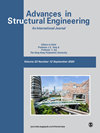投稿信息
稿件收录要求
Advances in Structural Engineering was established in 1997 and has become one of the major journals in the field of structural engineering. To better fulfil the mission of the journal, we have recently decided to launch two new features for the journal: (a) invited review papers providing an in-depth exposition of a topic of significant current interest; (b) short papers reporting truly new technologies in structural engineering. With the addition of these two new features, ASE publishes articles in the following categories:
- Research Papers
- Invited Review Papers
- Technical Notes
- New Technology Technical Notes
- Book Reviews
- Announcements
- Editorials
Invited Review Papers are state-of-the-art papers written by leading researchers at the invitation of the Editors-in-Chief. These invited papers will receive fast reviews (normally within 4 weeks) to speed up the publication process. Invited Review Papers, being a sub-category of full-length papers, are subjected to the same length and format requirements as Research Papers.
Short papers reporting New Technologies (NT) for the first time are a sub-category of Technical Notes and are thus subjected to the same length and format requirements of normal Technical Notes (up to 3000 word-equivalents). While NT Technical Notes on specific new technologies may be invited by the Editors-in-Chief when appropriate, most of them are expected to come from free submissions. NT Technical Notes will also receive fast reviews (normally within 4 weeks) to speed up the publication process. They are expected to report truly new structural engineering technologies with their feasibility and potential demonstrated to a reasonable level of certainty through pilot research. The new technologies can be new structural forms, new structural materials, new monitoring and control technologies, etc. The emphasis here is on technological innovations rather than in-depth studies of mechanics and the development of design methods that should follow. Some of these articles will be made freely accessible to non-subscribers, at the Editor’s discretion, so as to reach a wide range of interested readers.
Advances in Structural Engineering is a peer-reviewed journal that aims to provide a major publication channel for cutting-edge research on civil engineering structures (e.g. bridges, buildings and offshore platforms) in areas of significant current interest to the international structural engineering community. The current focus areas of the journal, which are periodically reviewed by the editors, are as follows:
(a) Structural use of composite and other emerging materials;
(b) Behavior of structural systems;
(c) Structures under extreme conditions (e.g. earthquakes, strong winds, fires and blasts etc.);
(d) Performance-based structural engineering;
(e) Life-cycle structural engineering;
(f) Structural health monitoring for performance assessment; and
(g) Sustainability in structural engineering.
Notwithstanding these focus areas, papers of significant impact or lasting value in other areas of structural engineering are also welcome.
Acceptance of a paper for publication in the journal is subjected to the manuscript being an unpublished work presenting a significant original contribution or an in-depth state-of-the-art review of a specific topic of significant current interest to the journal’s readership. Apart from full-length papers, short technical notes, discussions, and book reviews may also be published.




